After getting our bearings and kyats (the local currency, pronounced “chats”) in Yangon, we decided to visit Bago, a bustling small town a two-hour drive northeast. The decision to travel here was primarily due to having three weeks in the country and a large gap of where to go. While we initially marked numerous cities that we thought we could visit, upon arrival in Yangon we found there were travel restrictions preventing us from doing so. The government is particularly paranoid about tourists getting hurt or injured, so the moment even a small incident of civil unrest occurrence, that region is marked out of bounds for foreigners. So we elected to move in unrestricted areas and created an eight-day route that explored the Mon State (a region mainly southeast of Yangon). To get to Bago (our first destination after Yangon), we hopped on a locals’ bus for a pleasant, but dusty ride.
As the only foreigners on the bus, we felt like we were definitely off the normal tourist track. Adults and children alike gawked and smiled at us as though we were the first foreigners they had ever seen. To our surprise, a woman in front of us spoke English. Since we didn’t know when to get off, she asked the bus attendant to let us know when we reached our destination. Upon exiting the bus and without any prompting, an old man who spoke English helped us negotiate two motorbike taxis to our hotel. We were a little wary about this mode of transportation since we had all our bags, but for less than $1, we said ok and jumped on. The drivers took off with the greatest of ease, tearing through the dusty uneven streets. It was a little harrowing trying to stay balanced on the back with two backpacks strapped to me, but the five-minute drive was over soon enough (Riding a motorbike taxi at night on the other hand can cause more than a few gray hairs).
We chose to stay at the San Francisco Hotel, which ended up being a solid choice, as it is centrally located, clean, fairly cool at night, and has a friendly staff of two English-speaking middle-aged sisters.
Bago tends to be sold as a day trip from Yangon, and depending on your transportation acumen, this is feasible, but since we were headed in a southeasterly direction afterwards, it made more sense to dedicate a couple days to looking around here. The main draw to Bago seems to be an enormous Burmese python and two giant reclining Buddhas. If you are interested in seeing these and the sights of the city, get ready for a fun scavenger hunt.
While the city is small enough, the backstreets are a zigzagging maze of confusion. On our first day, we waited until the late afternoon to set out for the golden Shwemawdaw Paya. Our guesthouse told that if we entered after 4:30pm and through any gate but the west we would not have to pay the $10 entrance fee. But we also learned a valuable lesson in Yangon: midday sightseeing during the hot, hot season will burn and dehydrate you (That said, during our entire time in Myanmar, we ended up visiting temples during the heat of the day. We never planned it, it just would always happen. Since we had to shed our shoes, our feet, by the end were blacken ciders. Okay, maybe not that bad.). We didn’t need to stray far from the main road to find the Shwemawdaw Paya. Its golden hti on top is visible from many points in the city, making it easy to locate on your own. We avoided paying an entrance fee and found a place to watch the paya change shades of gold as the sunset.
The next day, while hunting for the location of the Snake Monastery, we found ourselves walking in circles. After running into the same motorcycle taxi drivers, we pulled out our “cheat sheet.” Earlier that day, one of the sisters at our guesthouse wrote the names of each sight in the local language so we could show it to anyone and ask for help. There was a flurry of waves and motion from the drivers. Their sign language directions were confusing, and from what we gathered the monastery was not even close. So we capitulated to one driver’s demands of 500 kyats (56¢) each to take us there.
The monastery is a couple windy back-road miles away from the where we thought it was and, thankfully in hindsight, the 500-kyat ride was easily the best deal of the day. Likewise, in our wanderings we found a passenger motorbike driver willing to take us around for 3,000 kyats (under $4 USD) for the day! Foolishly we waved him off, but if approached with this offer, it is definitely worth it. (A passenger motorbike is a cross between a motorcycle and a songthaew.)
Which brings us to the Snake Monastery, a small compound of buildings under construction, except a relatively small, one-room structure that has a steady stream of people flowing in and out of it. We exotic foreigners even briefly became as much of a star attraction as the 120-year old Burmese python before everyone realized he was far more interesting. Taking pictures of the python will attract the attention of the snake’s handlers who will try to solicit donations. We saw most people tossing 200-kyat bills into the bowls so we did the same. The python is partially submerged in an oversized tub and we never felt unsafe because we read that the snake is fed live chickens on a weekly basis (be aware there is no glass or cage to protect you, but pythons are constrictors, so they are not poisonous).
After taking a couple pictures and trying to imagine if we could fit inside him, we took off and headed to a nearby zedi (Shwetaungyoe Paya). Zedis are the golden bell-shaped structures situated in the center of a temple. It is also worth noting that they usually contain a holy relic (in the case of central and southern Myanmar, this relic is almost always a strand of Buddha’s hair or a tooth).
A short walk from the monastery (not recommended in the heat of the day, like we ended up doing) is Shwetaungyoe Paya; a small elevated zedi perched on a hill. The view is a panorama of the surrounding area. It’s not too exciting, but you can see other zedis peaking out from the palm and banana trees and even a decent view of the golden Shwemawdaw Paya in the distance.
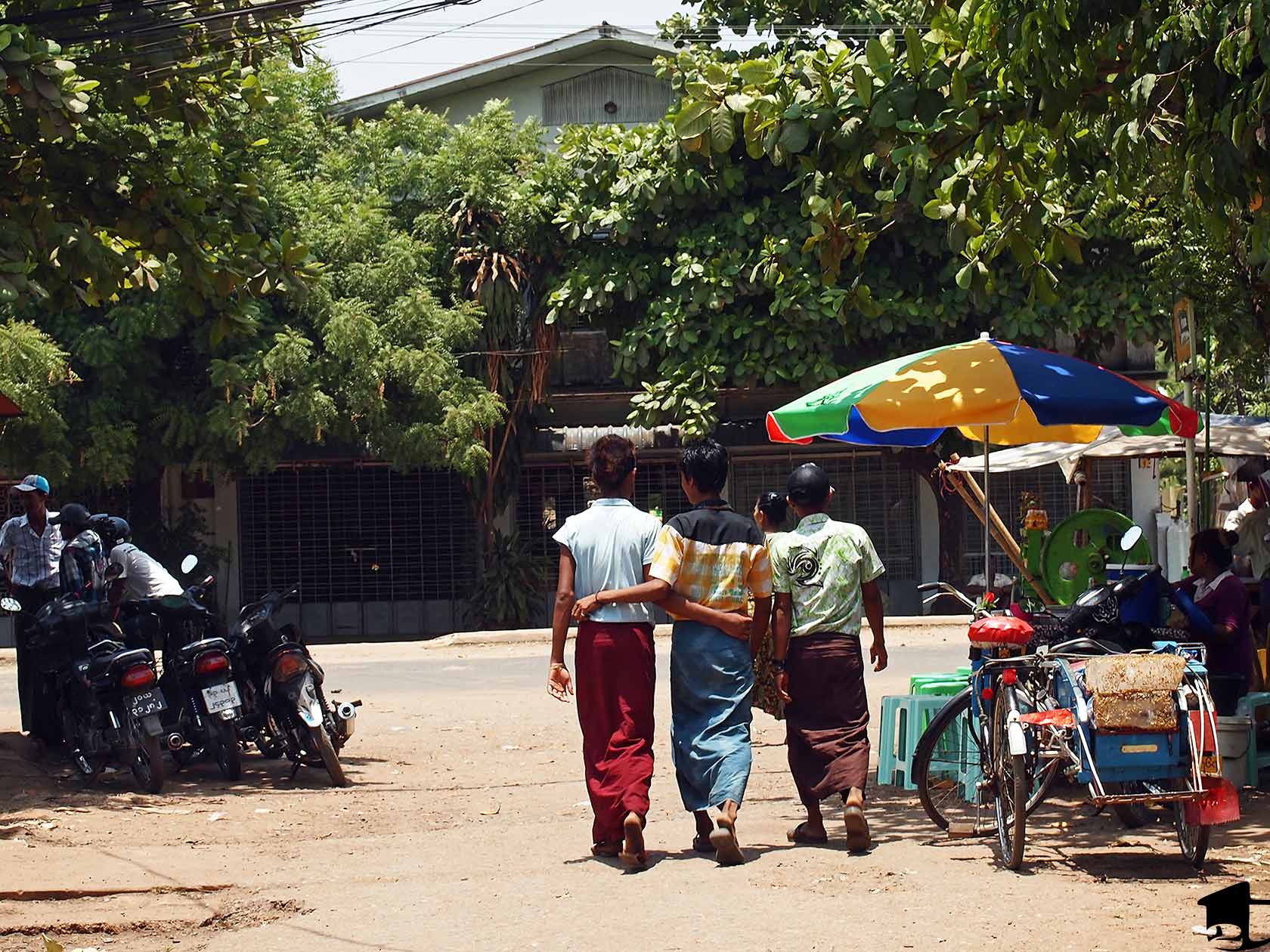 Since our driver to the monastery took off and there were no taxis hanging around the bottom of the Paya; we opted to amble back to our hotel (once again, early afternoon is not optimal when it comes to walking a couple miles.). This afforded us the opportunity to interact with locals who were surprised to see foreigners wandering through their back roads without a guide. After a couple smiles and “mingalabas” (hellos) we felt like celebrities. Nobody hassled us, far from it — the people would come up and ask us where we were from and maybe our names. Then they would thank us and say goodbye. Sadly, the complexity of these conversations never reached a further depth because of their basic English-language skills, but they were pleasant enough.
Since our driver to the monastery took off and there were no taxis hanging around the bottom of the Paya; we opted to amble back to our hotel (once again, early afternoon is not optimal when it comes to walking a couple miles.). This afforded us the opportunity to interact with locals who were surprised to see foreigners wandering through their back roads without a guide. After a couple smiles and “mingalabas” (hellos) we felt like celebrities. Nobody hassled us, far from it — the people would come up and ask us where we were from and maybe our names. Then they would thank us and say goodbye. Sadly, the complexity of these conversations never reached a further depth because of their basic English-language skills, but they were pleasant enough.
After collapsing in a sweaty mess for a couple hours, drinking a lot of water and cooling down, we opted to go east. This direction held the remaining attractions of the city: payas and Buddhas. Lonely Planet guidebooks refer to Bago as a Disney Land of Buddhist structures, but you couldn’t climb to the top of Buddha or slide down a zedi into a pool, so we kindly disagree.
Now, this was early into our journey around Myanmar, but I was already beginning to feel a little weary of visiting so many temples. In Europe, you have churches and cathedrals, in the Middle East and Muslim countries you have mosques, and here in Southeast Asia you have temples. I was afraid of getting burnt out of seeing so many temples. However, even when consecutive days were filled with visiting Buddhist sights, it never got old (wait till you read what Bagan had to offer).
We flagged down a passenger motorbike, which are cheaper than motorbike taxis, and showed the driver our “cheat sheet.” He nodded and motioned for us to jump on. We drove for a while down a rocky road I wouldn’t even want to ride a mountain bike on. It dead-ended with the whitewashed Mahazedi Paya. This temple has two special distinctions in our book: it was the only location we had to pay a camera fee (300 kyats ≈ 33¢) in all of Myanmar and was the first place Mike was able to ascend to a higher level (a long stairway that led to a platform next to the zedi), while females are forbidden (sorry, Tara).
Sexism aside, the view from the top of the paya was breathtaking, as was finally being high enough to see the individual chimes that adorn the hti at top of a zedi. Think of wind chimes made of gold, gems and jewels. The view far exceeded the one we had only a few hours previously. Whereas Shwetaungyoe Paya was a couple kilometers away from anything noteworthy, Mahazedi Paya was higher and within walking distance from several amazing sights. After taking in the view and descending back to my wife, we began to wander to the Shwethalyaung Buddha.
Before we got there, we ran into six men playing sepaktakraw (think hanky sack combined with volleyball). It is one of the most physically demanding games, as three players on each side work as a team to score on their opponents by contorting their bodies to kick, head, or bounce a rattan ball over a net (but never with their arms or hands). We saw more bicycle kicks in the span of a few minutes than during entire soccer matches. It is truly an amazing sport to watch.
Unfortunately, we were starting to lose light, so we continued our walk to our first reclining Buddha of Myanmar. Shwethalyaung Buddha is a 180-foot reclining Buddha inside a nice covered viewing area. Posted signs detailed various measurements of Buddha’s body parts (the ear is 15 feet long!). Behind the Buddha are paintings that tell the tragic love story of how Buddhism came to Myanmar and how the reclining Buddha was built as a result of its arrival around 994 AD (sadly, the structure was destroyed in the sacking of the city in 1757 but has been restored a couple times since then). The most fascinating sight was the ornamental decoration on the Buddha’s feet. There were 108 auspicious characters found on the feet of this, and apparently all, reclining Buddhas (but do not ask me what they mean).
We followed this reclining Buddha with another reclining Buddha (Naung Daw Gyi Mya Tha Lyaung), though this one was much larger (clocking in at 250 feet long) and fully exposed to the outside elements. It is also newer, apparently built in 2002 by funds that were mostly local donations. Overall, the Shwethalyaung Buddha was far more interesting and elaborate, but since this one is a very short walk away, visitors may as well stop here too.
Last on our list of sights to see was the Four Figures Paya, which is essentially four large standing Buddhas with their backs to each other. This was probably the most underwhelming sight since we had seen quite a bit of remarkable architecture. Tara wandered around taking some photos and was stopped by a friendly local who wanted to practice his English. This was just the beginning of many friendly encounters we had in the not-as-touristic southeastern region of Myanmar.
After a long, hot day of seeing Buddhas, zedis, and temples, we flagged down a passenger motorbike to call it a day. By now, we knew what the rate back to the hotel should be (200 kyats each), so we nearly did a spit take when the driver asked for 3,000 kyats (each!). I laughed and waved him off, but the driver persisted, even following us until he agreed to the regular price. Considering that our sightseeing walk had taken us almost halfway back to the hotel, we were not about to be overcharged and taken advantage of to that extent.
Bago ended up being a nice surprise of a town. We were still a little green around the gills when it came to figuring out Myanmar, but we were getting there. The friendly people were rubbing off on us. Their smiles and the chorus of “mingalabas” were making us smile more and return their greetings. We could not put a finger on what was so different about this country, but we knew even then that we were starting to fall in love with it.
LOGISTICS
Bus
Public bus (non-A/C, open-window style) from Yangon to Bago: 1,000 kyats per person, runs everyone hour. There was no under-the-bus storage for our bags, and we were not allowed to keep them in the aisle, so we had to pay 1,000 kyats each for them as well since they took up paying seats. If possible, get there a little bit before you want to leave, as seats fill up fast on a first-come, first-filled basis.
A/C buses from Yangon to Bago exist as well.
Hotel
San Francisco Hotel: $15 USD for a large double room with a fan, balcony and ensuite bathroom. It did not include breakfast. There was a container of purified water downstairs that we were allowed to use to fill up our water bottles. The receptionists were friendly and spoke good English. They also booked our bus tickets to Kinpun, our next destination.
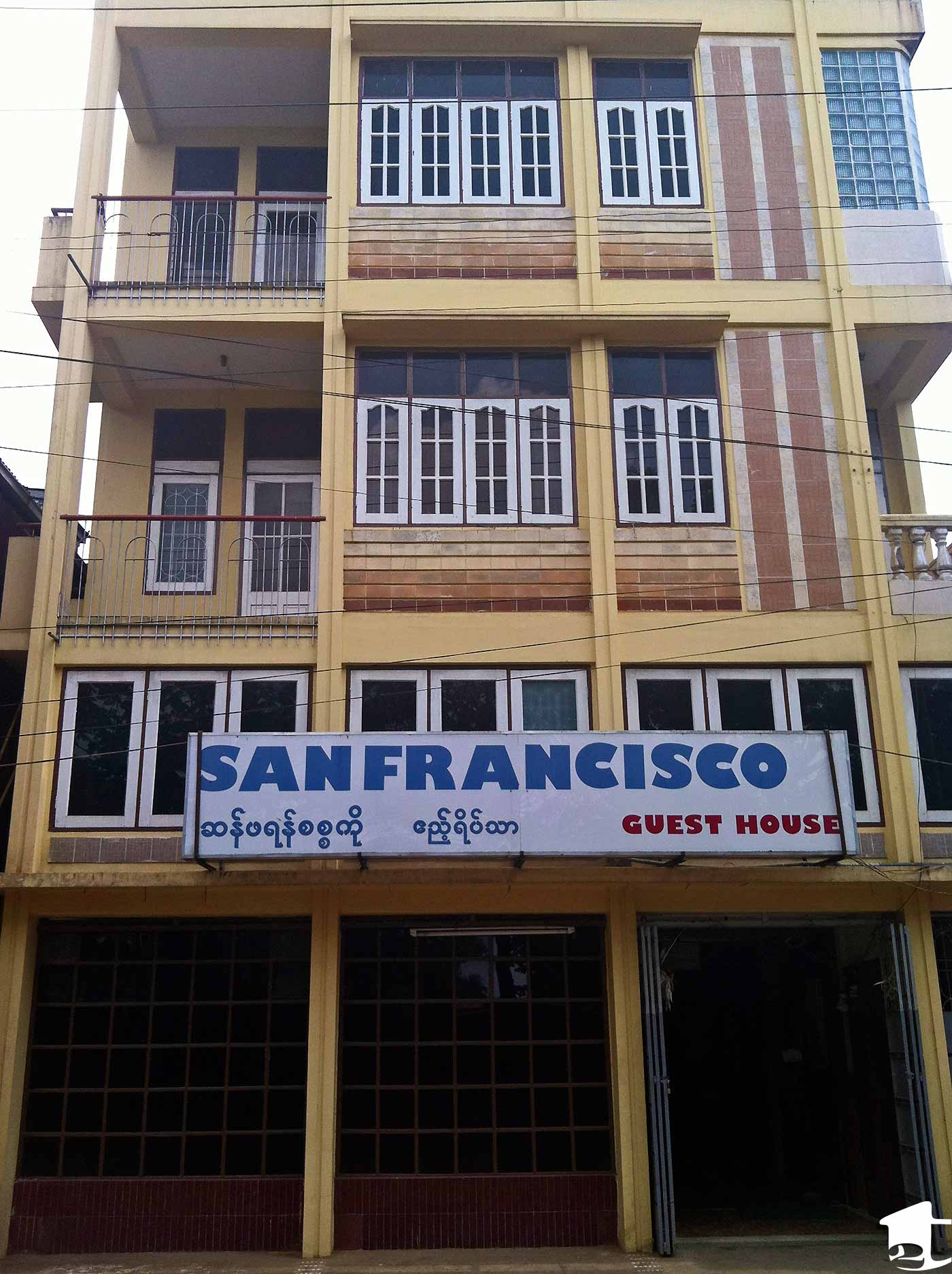
Around town
There’s supposedly a mandatory $10 fee that buys you a ticket to each attraction around the city. We were never asked to purchase it or show proof of purchase. We were told that if you visit the larger attractions before 8:30am and after 4:30pm, you will not be required to buy the ticket. Likewise, if you enter through any gate but the west gate at the Shwemawdaw Paya you can avoid the fee as well.
Find out here why we choose to use Myanmar instead of Burma.
Determine a budget for your trip to Myanmar.
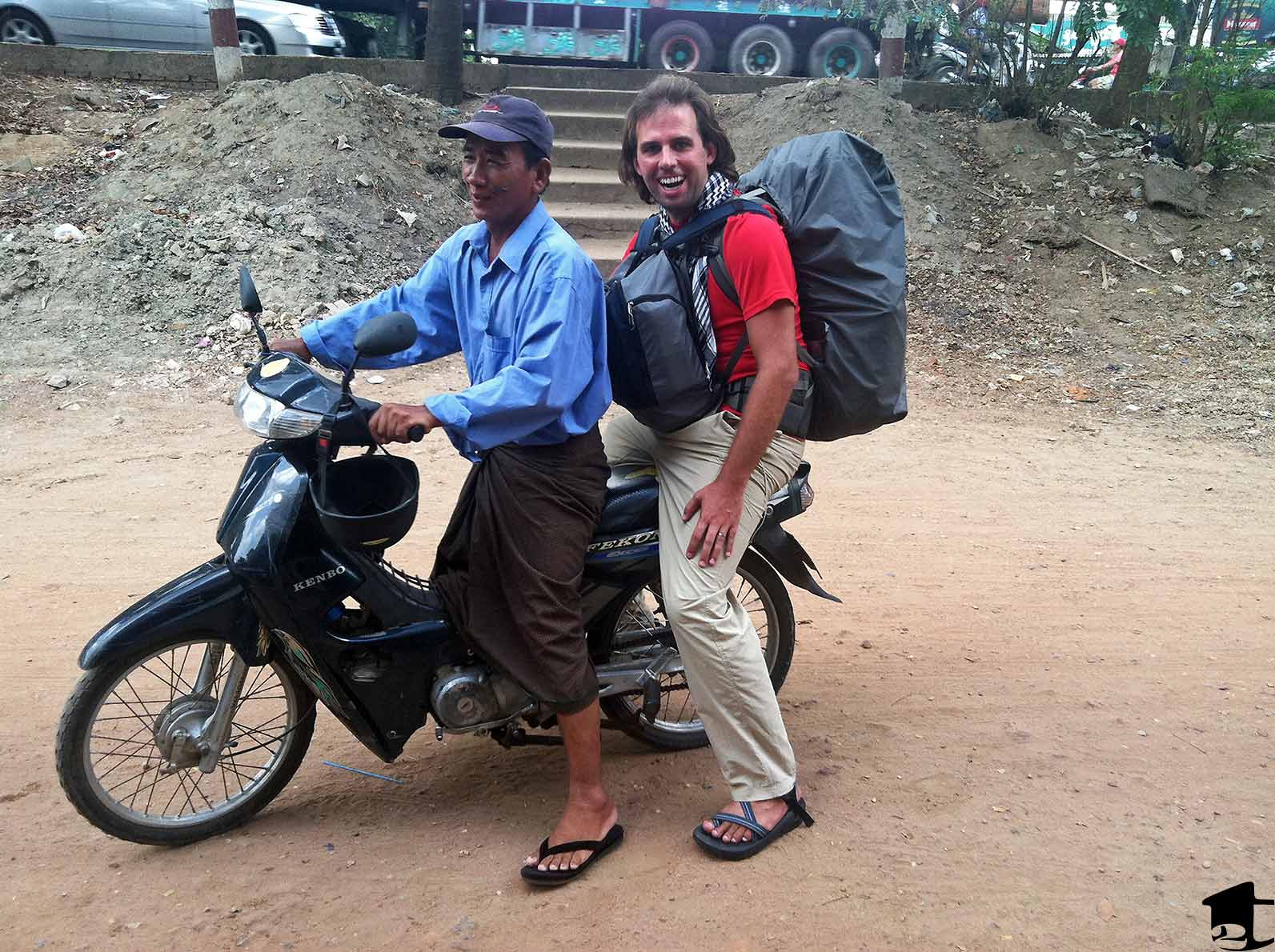
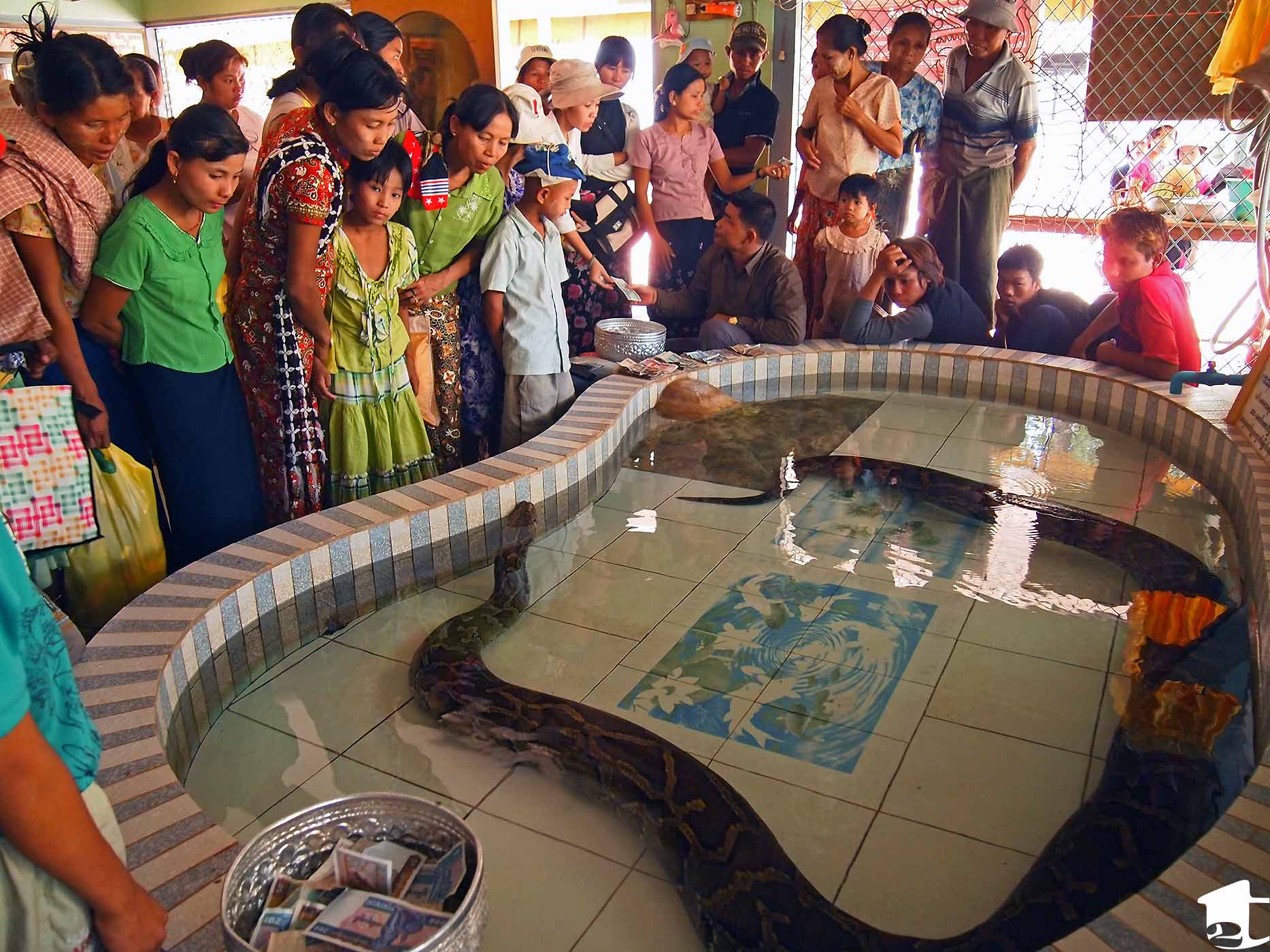
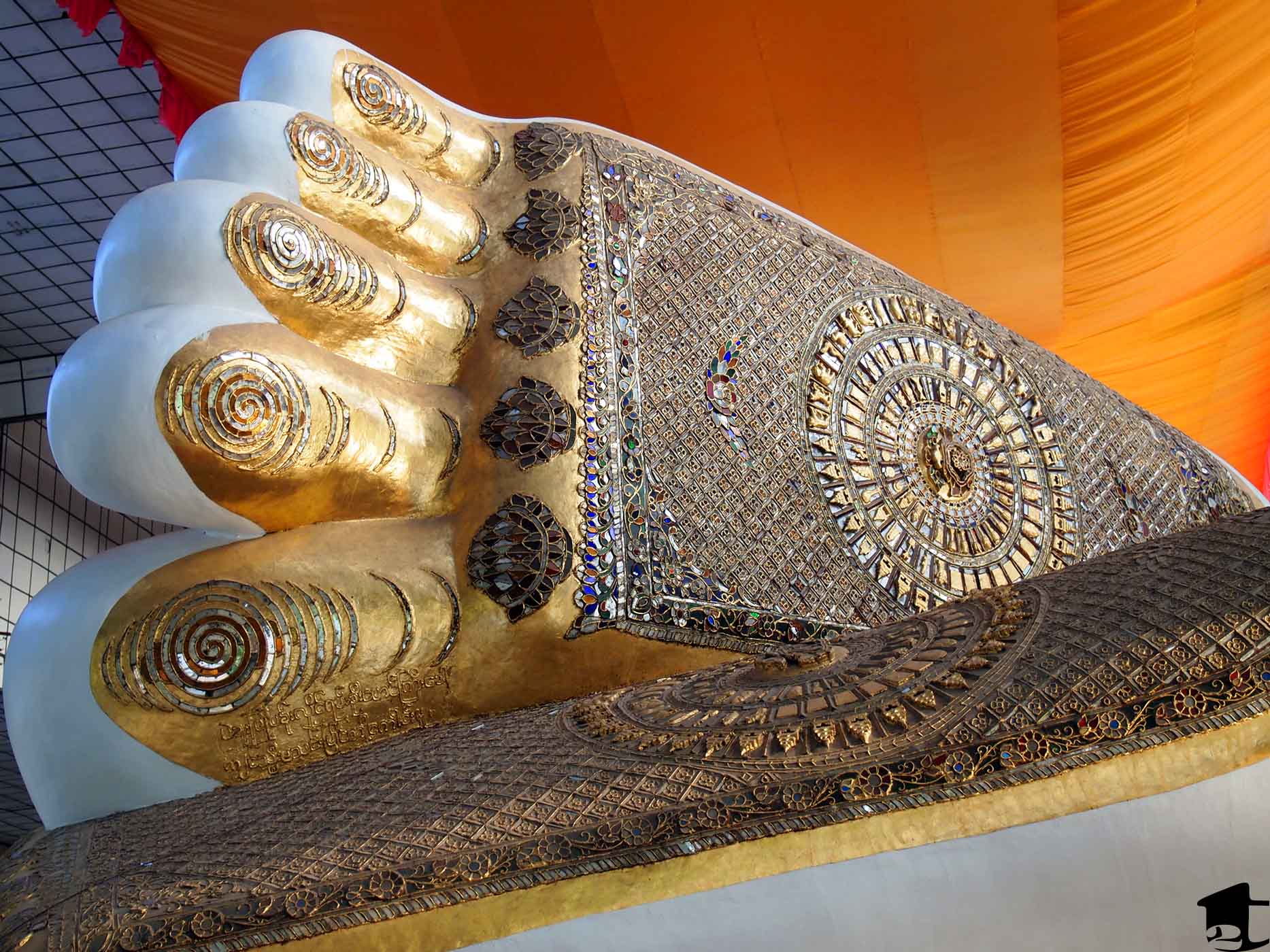












All of this is so interesting to read now that we have been there. Camera fees, limited access to women at certain temples, smiling faces with “mingalaba”. It is interesting that they charged you for your bags on the bas, saying you can’t keep them in the aisle. I guess it is because they often sell that space to people as extra seats. Can’t wait to hear more about the trip, and ultimately whether you got templed out!
The bus did fill up, so we were okay with paying the extra couple kyat so that our bags were not tossed around. As for getting “templed” out, we did run into a few foreigners who had been, but even after a couple days in Bagan, we were able to find a balance in activities that kept us loving those golden (or brick) things.
Upon returning to Bangkok, we found that the guesthouse here had a Kayin receptionist so we have still been dropping mingalaba’s until we leave for Cambodia.
Great tips on visiting Bago, you guys! We still don’t know yet if we’ll make it to Myanmar (would love to know what you wound up spending… we’ve been temporarily terrified by people saying they were spending, like, $80US/day!) but these are great tips nonetheless.
Interesting to hear that the people of Myanmar have already gotten into the swing of trying to rip of tourists & haggling is a must! Can’t believe that guy asked for 3k per person!
Insane, huh? We have another article coming out soon that will be a comprehensive breakdown of USD versus MMK, ATMs versus bringing cash in with you, and an overview of prices we paid. Look for it in the next week or so.
Mike, are you aware that a company offers balloon rides to view the temples at Bagan? Beats having to run around and there are over 4400 there!
Sadly, hot air balloons don’t fly in the rainy season (which is when we were there). However, we elected to get around via horse drawn carriage, romantic and practical.
Much like your mom and me in our beat up old cars, eh? We find that romantic, no kids around. Glad you enjoyed everything with Tara, you guys ROCK!!